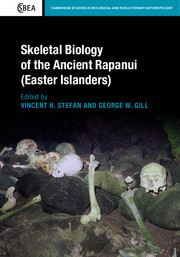Book contents
- Frontmatter
- Contents
- List of contributors
- Acknowledgements
- 1 Introduction: Research overview
- 2 Review of Polynesian and Pacific skeletal biology
- 3 Chronology and Easter Island prehistory
- 4 A descriptive skeletal biology analysis of the ancient Easter Island population
- 5 Craniometric variation of the prehistoric Polynesians and Rapanui
- 6 Rapanui non-metric cranial traits
- 7 Intra-island discrete cranial trait variation
- 8 Continuous non-metric characteristics of the early Rapanui
- 9 Rapanui dental morphology
- 10 Pelvic variability and sexual dimorphism in prehistoric Rapanui
- 11 Genetic affinities of the Rapanui
- 12 Archaeogenetics and paleodemographic estimation of founding populations: Features of residential geography on Rapa Nui
- 13 Evidence for injuries and violent death
- 14 Demographic analysis of modified crania from Rapa Nui
- 15 East Polynesian and Paleoindian parallels and contrasts in skeletal morphology
- 16 Rapanui origins, relationships, and warfare: A summary in theoretical context
- References
- Index
6 - Rapanui non-metric cranial traits
Published online by Cambridge University Press: 05 December 2015
- Frontmatter
- Contents
- List of contributors
- Acknowledgements
- 1 Introduction: Research overview
- 2 Review of Polynesian and Pacific skeletal biology
- 3 Chronology and Easter Island prehistory
- 4 A descriptive skeletal biology analysis of the ancient Easter Island population
- 5 Craniometric variation of the prehistoric Polynesians and Rapanui
- 6 Rapanui non-metric cranial traits
- 7 Intra-island discrete cranial trait variation
- 8 Continuous non-metric characteristics of the early Rapanui
- 9 Rapanui dental morphology
- 10 Pelvic variability and sexual dimorphism in prehistoric Rapanui
- 11 Genetic affinities of the Rapanui
- 12 Archaeogenetics and paleodemographic estimation of founding populations: Features of residential geography on Rapa Nui
- 13 Evidence for injuries and violent death
- 14 Demographic analysis of modified crania from Rapa Nui
- 15 East Polynesian and Paleoindian parallels and contrasts in skeletal morphology
- 16 Rapanui origins, relationships, and warfare: A summary in theoretical context
- References
- Index
Summary
Introduction
Rapa Nui has long fascinated anthropologists due to the so-called “mysteries of Easter Island” made famous by Katherine Routledge and Thor Heyerdahl. One of these “mysteries,” from where the Rapanui came, was largely resolved in the 1960s with the pioneering work by Murrill (1965) followed by that of Howells (1970). Further refinement began in the 1990s through corrections in Murrill's work (Baker and Gill, 1997), analysis of mtDNA (Hagelberg, 1995; Hagelberg et al., 1994), extensive cranial metric analysis (Stefan, 2000), and the analysis of non-metric cranial traits (Chapman, 1999), in addition to archaeological (summarized by Weisler and Green, 2011) and linguistic studies (Marck, 1996; Pawley, 1996). These various approaches demonstrated a Polynesian origin for the islanders, focusing on the region around Mangareva or the Tuamotus as the most probable location for the source population (Chapman, 1999; Stefan, 2000). However, recent attention to issues of contact with the Americas has reopened the question of an American contribution to Rapanui population history (Jones, 2011; Matisoo-Smith, 2011; Ramírez-Aliaga, 2011; Scaglion and Cordero, 2011; Storey et al., 2011; Thorsby, 2010).
Early genetic studies of the Rapanui (Hagelberg, 1995; Hagelberg et al., 1994) find no evidence for an American contribution to the Rapanui gene pool. All 12 of the Rapanui examined, from Ahu Tepeu and Ahu Vinapu in the west of the island, demonstrate the 9 base pair deletion and point substitutions at three particular locations (16217, 16247, and 16261) that are considered “Polynesian markers.” However, the limited distribution and size of the samples suggest the possibility that a potential American contribution may have simply been overlooked because it was not evident in the lineages that buried their dead at those particular ahus. This is relevant given the assertion by Gill and Owsley (1993) for a social division on the island that restricted gene flow between groups in the east and west. Their argument is based on the unusual distribution of three rare skeletal anomalies: Bipartite patella, ankylosed sacroiliac joint, and a supracondylar foramen on the humerus. A bipartite patella and its less extreme manifestation, the vastus notch, is found in approximately 80 percent of a sample from Anakena, in the northern part of the island, but in less than 8 percent from a site on the Western coast (Ahu Kihi Kihi Rau Mea).
- Type
- Chapter
- Information
- Skeletal Biology of the Ancient Rapanui (Easter Islanders) , pp. 108 - 118Publisher: Cambridge University PressPrint publication year: 2016



